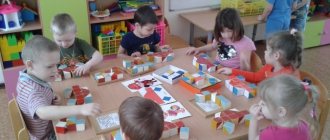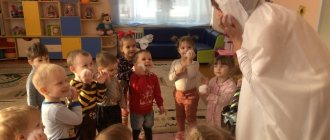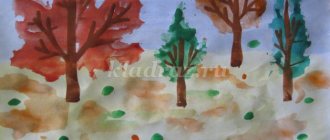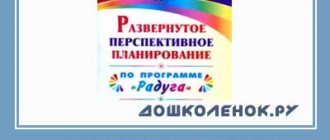Preparatory group. Senior preschool age. Children 6-7 years old
Instructor program for physical education of children 6–7 years old (2) Lesson No. 27 Game exercises. 1. “Ball against the wall”
.
2. “Be nimble
. L.I. Penzulaeva p.32. Lesson No. 28 1. Jumping over a short rope, rotating it forward. 2. Crawling on a gymnastic bench on your palms and knees with a bag on your back. 3. Throwing the ball to each other while standing in lines...
Physical education instructor program for children 6–7 years old (1) Work program Educational area “Physical development”
(6-7 years old)
Program passport Program status: work program for the implementation of the educational area
“Physical development”
Category: children 6- 7 years
(school preparatory group)
Duration of development: 1 year Scope…
Physical education and sports clubs in preschool educational institutions - Program for the physical development of children 5–6 years old (2)
Publication “Program for the physical development of children 5–6 years old...” Lesson No. 23 1. Climbing the gymnastic wall in the same way, walking along the rail of the gymnastic wall with an added step, going down without missing the rails (2-3 times. 2 Jumping on two legs over the cord on the right and left, moving forward (distance 3 m) - 3-4 times. 3. Walking with...
Program for the physical development of children 5–6 years old (1) Requirements for the level of mastery of the work program By the end of the year, the child must know and be able to (the child must have developed the following knowledge and skills): Be able to maintain correct posture. Developed motor skills and abilities, the ability to creatively use them in independent...
Physical development program for children 5–6 years old Lesson No. 23 1. Climbing under the cord, without touching the floor with your hands, straight and sideways (several times in a row. 2. Balance - walking on a gymnastic bench sideways with an extended step, hands on the belt. 3. Jumping on two legs between 4-5 objects placed in a row (4-5 pieces, at a distance of 0.5 m...
A work program on physical development for pupils aged 4–7 years of a group with a general developmental focus. A WORK PROGRAM in the educational field “Physical Development” for pupils aged 4–7 years with a general developmental focus. The Federal State Educational Standard of preschool education determines the goals, objectives and content of the physical development of preschool children in preschool settings. They can...
Plan of the “Pochemuchka” circle in the preparatory group
Explanatory note
Teachers of educational institutions believe that the task of preparing a child for school is not limited to acquiring knowledge and academic skills. It is much more important to develop a preschooler’s attention, thinking, speech, to awaken interest in the world around him, to develop the ability to make discoveries and be surprised by them.
From birth, children are surrounded by various phenomena of inanimate nature: the sun, the wind, the starry sky, the crunch of snow underfoot. Children collect stones and shells with interest, play with sand and water; objects and phenomena of inanimate nature are part of their life activities and are objects of observation and play. This circumstance makes it possible to systematically and purposefully familiarize children with the phenomena of the surrounding world.
Psychologists have proven that the thinking of preschool children is visually effective and visually imaginative. Consequently, the process of teaching and upbringing in kindergarten should mainly be based on visual and practical methods. This principle is especially important to observe when implementing natural science and environmental education.
Today, children's experimentation is becoming especially popular. Its main advantage is that it gives the child real ideas about the various aspects of the object being studied, about its relationships with other objects and with the environment. Experiments have a positive effect on the emotional sphere of the child, on the development of creative abilities, on the formation of work skills and the promotion of health by increasing the overall level of physical activity. During the experiment, the child’s memory is enriched, his thought processes are activated, since the need constantly arises to perform operations of analysis and synthesis, comparison and classification, and generalization. The need to give an account of what was seen, to formulate discovered patterns and conclusions stimulates the development of speech. The task of the teacher in the process of experimental activities is to connect the results of research work with the practical experience of children, their existing knowledge and lead them to an understanding of natural laws, the foundations of environmentally literate, safe behavior in the environment.
Understanding the importance of experimentation for the development of a child, the kindergarten has developed a plan for the “Pochemuchka” circle for children in the school-preparatory group. The leading idea of the circle is to organize feasible, interesting and age-appropriate experimental research activities for the formation of natural science concepts of preschoolers.
The goal of the program is to promote the development of children's cognitive activity, curiosity, desire for independent knowledge and reflection through experimental activities.
Tasks:
1. Expand children’s understanding of the world around them through familiarization with basic knowledge from various fields of science.
2. Develop in children the ability to use assistant devices when conducting experimental games.
3. Develop mental abilities.
4. Social and personal development of the child: development of communication, independence, observation, basic self-control and self-regulation of one’s actions.
Mastering the program material of the Pochemuchka circle is designed for one academic year.
Joint activities between the circle leader and students are organized once a week, lasting 30 minutes.
To begin mastering program material, there are no specific requirements for students. What is important is that the general development of preschool children corresponds to their age period. At the same time, if a child has not previously attended a club, then at any stage of education he can begin to attend it. The program is designed for both children who are weak in their development and for gifted ones, and the pace of their progress through the program will be different.
As a result of mastering the content of the program, it is expected that students will develop stable natural science knowledge and ideas, develop research skills, as well as independence in the process of experimental activities and application of knowledge in practice.
Forward planning
| Month | Subject | Tasks | Preliminary work | Equipment | Working with parents |
| October | Getting to know the equipment for experi- cops | Introduce children to the instruments that are necessary for carrying out experiments and experiments. Remember and reinforce safety rules when working with equipment. | Magnifying glasses, scales, hourglasses, compass, magnets Various vessels made of various materials (plastic, glass, metal) of different volumes and shapes Medical materials: pipettes, flasks, wooden sticks, syringes (without needles, measuring spoons, rubber bulbs, etc. ; Other materials: mirrors, balloons, butter, flour, salt, sugar, colored and clear glass, nail file, sieve, candles, etc. | ||
| Why do leaves turn yellow in autumn? | Expand children's knowledge about the phenomena of living and inanimate nature: why leaves turn yellow and fall and how they fall. Learn to establish cause-and-effect relationships. Show children the relationship between leaf color and a decrease in the thermal factor: as the temperature decreases, the color of the leaves changes (in autumn it is colder than in summer) | Observation while walking (leaf fall, colorful leaves). Didactic game “Which tree is the leaf from?” Reading fiction: M. Evensen "Leaves are falling." View presentation viki.rdf.ru | Birch tree growing on the playground, weather calendar, outdoor thermometer, temperature graph. Multimedia equipment: laptop, projector, screen Magnifying glasses, a microscope, pieces of white fabric folded in half; wooden cubes. The leaves are real large and small, of different shapes | Walk to the park, forest. Participation in joint events - an exhibition in the group “Crafts made from natural materials”. | |
| Living piece | Help children establish that root vegetables contain a supply of nutrients for the plant. | Looking at vegetables. Didactic games “Wonderful bag”, “Guess the taste”. Reading fiction about vegetables. View presentation viki.rdf.ru | Flat container with water, root vegetables: carrots, beets; experiment algorithm, worksheet. | ||
| November | “Plastic: its qualities and properties” | Teach children to recognize plastic objects. Encourage children to determine its qualities (smooth or rough, products made from it are painted in different colors) and properties (waterproof, brittle, melts, flexible). Cultivate an interest in modern materials. | On a walk, I show the children a little experiment with plastic - a small plastic plate and heat it over an alcohol lamp. The plastic plate melts, burns, and smells strongly. | Various in shape, color, size of plastic products (plastic cups, electric kettle, desktop organizer, telephone), water, plastic plates, alcohol lamp, matches; algorithm for describing material properties. | |
| "Metal: its qualities and properties" | Recognize objects made of metal, determine its qualitative characteristics (surface structure, color) and properties (thermal conductivity, malleability, metallic luster). Help you understand that only metal objects interact with a magnet. | Games with metal objects in the experimentation corner (constructor), games with a magnet. | Metal objects, a container with water, a candle, a magnet, a chest, wooden and rubber objects, illustrations on the topic, mittens with a magnet, a sheet of paper, a costume for a game character. | ||
| "Paper: its qualities and properties" | To form children’s ideas about paper, its different types, qualities and properties of paper, the history of its creation; develop investigative activities and be able to establish cause-and-effect relationships between the quality of paper and its purpose. Cultivate an interest in learning about the world around us. To acquaint children with the appearance of paper, its production, types, use in everyday life and the national economy; cultivate an economical, careful attitude towards paper. | Screening of the cartoon “Fixies. Paper making" | Different types of paper; containers with water, scissors, a square sheet of white paper. | Make an album-collection “Types of paper”. | |
| "Wood: its qualities and properties" | Learn to recognize things made from wood (identify its qualities (hardness, surface structure - smooth, rough; degree of strength (thickness) and properties (cuts, burns, does not break, does not sink in water). | Wooden objects, containers with water, small planks and bars, an alcohol lamp, matches, a shoe knife, a presentation “What is made of wood”; cuts for counting annual rings; thermos with hot water, mug. | |||
| December- ry | Do plants need snow in winter? | Help children identify the role of snow in plant life. | View the presentation “Winter”, “Where does the dirt come from in the snow?” Didactic game “It happens - it doesn’t happen.” Reading fiction I. Belousov “The First Snowball”, I. Nikitin “Bittering frost and crackling”. | 2 containers of water, snow. | Joint walks between parents and children. Invite parents to observe changes in weather and nature with their children. |
| Ice and snow are also water | Reinforce and continue to introduce children to the properties of water. Develop the ability to generalize the results of work and draw conclusions. Bring children to understand that ice is also water in a solid state. Instill respect for water. | Containers with snow and ice, a small hammer, an alcohol lamp, napkins. | |||
| Manufactured melting of colored ice floes | Introduce children to the fact that water freezes in the cold and that paint dissolves in it. | Molds, jars, gouache paints, water. | |||
| Experience: “Water is soluble tel" | Clarify children's knowledge about the importance of water in human life. Strengthen the properties of water - water is a solvent. Explain why water sometimes needs to be purified and provide a basic understanding of the filtration process. Develop skills in laboratory experiments using diagrams - consolidate the ability to work with transparent glassware, observing safety rules with unfamiliar solutions. | Transparent cylindrical vessels of different sections (narrow, wide), shaped vessels, glass funnels and glass rods, filtered paper, magnifying glass, sugar, salt, calendula or chamomile tincture, mint infusion, vegetable oil. | |||
| January | "Fabric: its qualities and properties" | Recognize things made of fabric, determine its qualities (thickness, surface structure, degree of strength, softness) and properties (wrinkles, cuts, tears, gets wet, burns). | Samples of cotton fabric in two or three colors, scissors, an alcohol lamp, matches, containers of water, an algorithm for describing the properties of the material. | Make an album-collection “Types of fabrics”. | |
| "Glass: its qualities and properties" | Recognize objects made of glass; determine its qualities (surface structure, thickness, transparency) and properties (fragility, melting, thermal conductivity). | Items made from glass. Presentation "Dishes". A glass of water, paints, wooden sticks. | |||
| Magnet is a magician | Introduction to the concept of "magnet". Formation of ideas about the properties of a magnet. Updating knowledge about the use of magnet properties by humans. Formation of skills to acquire knowledge through practical experiments, draw conclusions, and generalizations. | Screening of the cartoon “Smeshariki. Magnetism" | Magnets, metal objects (paper clips, bolts, screws), cardboard, napkins, glasses of water, cereal. | ||
| Feb- rahl | Why is the light bulb shining? Experiments: “Miracle Hairstyle”, “Magic Balls”, “Twirler” | Introduce children to the principle of operation of an electric light bulb. Develop the ability to put forward hypotheses and assumptions, analyze, compare various facts, draw conclusions and conclusions. | A conversation about electricity and power plants. | Flat batteries, flashlight bulbs, connecting wires, switches, electrical circuit connection diagram, safety rules for using electricity at home. | |
| Sunny bunnies | Introduce a natural source of light - the sun. Introduce the origin of sunbeams, their movement, the objects from which they are reflected; develop ingenuity and curiosity. | Water, mirror, jar, stainless steel plate (for each child). | |||
| Shadow theater | Continue to become familiar with the properties of light and shadow. Develop creative imagination. Cultivate observation skills. | Lamp, screen, shadow theater figures. | Offer to make figures for a shadow theater together with the children. | ||
| How to see and hear electricity quality? | Demonstrate to children the manifestation of static electricity. | Warm sweater, pieces of wool or synthetic fabric, water, balloon, comb. | |||
| March | Sand and clay | Show the variety of inanimate objects. Comparison of sand grains by shape, color, size. Teach children to draw conclusions and observe safety precautions when conducting experiments. In the process of research activities, to develop children’s knowledge about the properties of clay. Give the child the opportunity to find answers to the questions: “How and why?” and draw conclusions; When conducting experiments, develop the child’s thinking, logic, and creativity. Visually show the connections between living and nonliving things in nature. Activate the vocabulary: “viscous, plastic, oily, flexible”, etc. | Samples of river, sea and other types of sand, small trays, oilcloths, magnifying glasses. Trays with clay for each child (dry and wet clay), wet napkins, magnifying glasses, cards with objects of living and inanimate nature. | ||
| Getting to know the stones. What types of stones are there? | Develop interest in stones, the ability to examine them and name their properties (strong, hard, uneven or smooth, heavy, shiny, beautiful). To give an idea that stones come from rivers and seas, that many stones are very hard and durable, which is why they are widely used in the construction of buildings, bridges, and roads. Introduce valuable stones that are used to decorate buildings and make monuments and souvenirs (granite, marble). Show products made from precious stones. Learn to classify stones according to different characteristics. | Ryzhova N. A. “What is under our feet” p. 77, Nikolaeva S.N. Introducing preschoolers to inanimate nature - M., 2003, p.23 | Sets of river and sea stones. Vessel with water, magnifying glass. Napkins for each child, plasticine, expanded clay, granite, lemon, flint, sugar, salt, “Box of sensations”. photo: monument to A.S. Pushkin, Monument to the Unknown Soldier, etc. | Collect a collection of stones. | |
| "Living Stones" | Introduce stones whose origin is associated with living organisms and ancient fossils. | On a walk: 1. Examination of stones (type, shape, structure, properties). 2. Laying out designs from stones. 3. Construction games (construction and decoration of buildings). | Variety of seeds of different garden plants. Soil, watering can, pot. | ||
| Introduction to the properties of air | Continue to familiarize children with the properties of air and the role of humans, plants, and animals in life. To give knowledge about inanimate nature and that air is a condition of life for all creatures on earth. Experimentally consolidate children's knowledge about air. Cultivate interest in the life around you and curiosity. | Balloons for each child, a jar of water, cups and straws, whistles, bottles, small pieces of paper, wind instruments. | |||
| April | Unknown new - nearby | Expand children's knowledge about the life of ancient man, about man's discovery of fire. How fire has reached our days, how it helps people. Form the idea that during combustion the composition of the air changes (there is less oxygen) and that combustion requires oxygen. Introduce fire extinguishing methods. When burning, ash, ash, and carbon monoxide are formed. Compliance with safety rules when conducting experiments. | Stones, a candle, a jar, a bottle with the bottom cut off, matches. | ||
| This mysterious space | Introduce children to the symbolism of constellations. Arouse interest in outer space. Expand your understanding of the astronaut profession. Activate vocabulary: space, astronaut, space weightlessness. | Photos of space, the solar system, Yu. Gagarin, spaceships. Flashlight, ruler. | |||
| Water cycle in nature | Introduce children to the water cycle in nature and the process of condensation. | View the presentation “What is spring?”, “Water”. Watching the educational cartoon “The Water Cycle in Nature.” | A saucepan with water and a glass lid. Laptop, projector and screen. | Invite parents to take their children for walks to the park or to a pond. Conduct observations of changes in nature. | |
| Evaporation of moisture from plant leaves | Give children the opportunity to check where the water disappears from the leaves of plants. | Looking at indoor plants in a group. D/i “Guess what kind of plant?” View the presentation "Flowers". | Plant, plastic bag, thread. | ||
| May | Unknown new seeds | Give children the opportunity, through an experiment, to become convinced of the need for soil for plant life, to understand how the quality of soil affects the growth and development of plants, and to identify different soil compositions. | View the presentation "Sunflower". Reading Literatures A. Platezhkov “The Unknown Flower”, A. Küpper “The Little Gardener”. | Variety of seeds of different garden plants. Soil, watering can, pot. | Invite parents and their children to prepare seeds and plant flowers in a flower bed near the kindergarten. |
| Why does a mosquito squeak and a bumblebee buzz? | Help children identify the reasons for the origin of low and high sounds. | View the presentation microcosm. Observation in nature. D/i “Who moves how”, “Who hid where”. | Audio recording with sounds made by insects, laptop, projector. | Joint walks with children in nature, observing insects. |
Used Books:
1. Cognitive and research activities of preschool children, Veraksa N. E., Galimov., O. R., ed. "Mosaic Synthesis", M. 2012.
2. Tugusheva G.P., Chistyakova A.E. Experimental activities of children of middle and senior preschool age, ed. "Childhood - Press", S-P, 2011.
3. Marudova E.V. Familiarization of preschoolers with the world around them” (experimentation), ed. "Childhood - Press", S-P, 2011.
4. Dybina O.V., Rakhmanova N.P. The unknown is near. Entertaining experiences and experiments for preschoolers. Sphere shopping center - Moscow, 2002
5. Isakova N.V. Development of cognitive processes in older preschoolers through experimental activities, ed. "Childhood - Press", S-P, 2013
6. Ryzhova N.A. What is under our feet, M.: Karapuz, 2005.
7. Nikolaeva S. N. Familiarization of preschoolers with inanimate nature, Moscow: Pedagogical Society of Russia, 2005.



